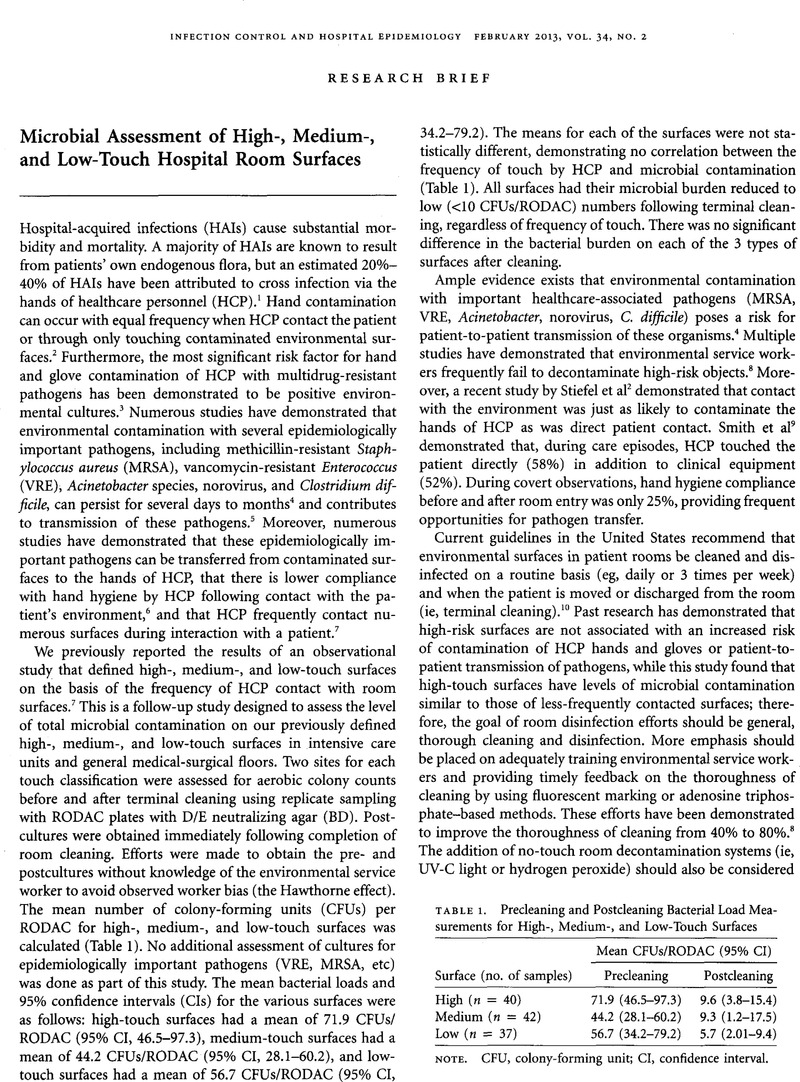Crossref Citations
This article has been cited by the following publications. This list is generated based on data provided by Crossref.
Weber, David J.
and
Rutala, William A.
2013.
Self-disinfecting surfaces: Review of current methodologies and future prospects.
American Journal of Infection Control,
Vol. 41,
Issue. 5,
p.
S31.
Weber, David J.
Anderson, Deverick
and
Rutala, William A.
2013.
The role of the surface environment in healthcare-associated infections.
Current Opinion in Infectious Diseases,
Vol. 26,
Issue. 4,
p.
338.
Rutala, William A.
and
Weber, David J.
2013.
Disinfectants used for environmental disinfection and new room decontamination technology.
American Journal of Infection Control,
Vol. 41,
Issue. 5,
p.
S36.
Walker, J.T.
2014.
Decontamination in Hospitals and Healthcare.
p.
3.
Rutala, William A.
Gergen, Maria F.
Sickbert-Bennett, Emily E.
Williams, David A.
and
Weber, David J.
2014.
Effectiveness of improved hydrogen peroxide in decontaminating privacy curtains contaminated with multidrug-resistant pathogens.
American Journal of Infection Control,
Vol. 42,
Issue. 4,
p.
426.
Saito, Yuhei
Yasuhara, Hiroshi
Murakoshi, Satoshi
Komatsu, Takami
Fukatsu, Kazuhiko
and
Uetera, Yushi
2015.
Time-dependent influence on assessment of contaminated environmental surfaces in operating rooms.
American Journal of Infection Control,
Vol. 43,
Issue. 9,
p.
951.
Whiteley, Greg S.
Derry, Chris
and
Glasbey, Trevor
2015.
Failure analysis in the identification of synergies between cleaning monitoring methods.
American Journal of Infection Control,
Vol. 43,
Issue. 2,
p.
147.
Whiteley, Greg S.
Knight, Jessica L.
Derry, Chris W.
Jensen, Slade O.
Vickery, Karen
and
Gosbell, Iain B.
2015.
A pilot study into locating the bad bugs in a busy intensive care unit.
American Journal of Infection Control,
Vol. 43,
Issue. 12,
p.
1270.
Lesho, Emil
Carling, Philip
Hosford, Eve
Ong, Ana
Snesrud, Erik
Sparks, Michael
Onmus-Leone, Fatma
Dzialowy, Nicole
Fraser, Susan
Kwak, Yoon
Miller, Sonia
Chukwuma, Uzo
Julius, Michael
McGann, Patrick
and
Clifford, Robert
2015.
Relationships Among Cleaning, Environmental DNA, and Healthcare-Associated Infections in a New Evidence-Based Design Hospital.
Infection Control & Hospital Epidemiology,
Vol. 36,
Issue. 10,
p.
1130.
Rutala, William A.
and
Weber, David J.
2016.
Disinfection and Sterilization in Health Care Facilities.
Infectious Disease Clinics of North America,
Vol. 30,
Issue. 3,
p.
609.
Rutala, William A.
and
Weber, David J.
2016.
Monitoring and improving the effectiveness of surface cleaning and disinfection.
American Journal of Infection Control,
Vol. 44,
Issue. 5,
p.
e69.
Caselli, Elisabetta
D’Accolti, Maria
Vandini, Alberta
Lanzoni, Luca
Camerada, Maria Teresa
Coccagna, Maddalena
Branchini, Alessio
Antonioli, Paola
Balboni, Pier Giorgio
Di Luca, Dario
Mazzacane, Sante
and
Chang, Yung-Fu
2016.
Impact of a Probiotic-Based Cleaning Intervention on the Microbiota Ecosystem of the Hospital Surfaces: Focus on the Resistome Remodulation.
PLOS ONE,
Vol. 11,
Issue. 2,
p.
e0148857.
Kanamori, Hajime
Rutala, William A.
Gergen, Maria F.
and
Weber, David J.
2016.
Patient Room Decontamination against Carbapenem-Resistant Enterobacteriaceae and Methicillin-Resistant Staphylococcus aureus Using a Fixed Cycle-Time Ultraviolet-C Device and Two Different Radiation Designs.
Infection Control & Hospital Epidemiology,
Vol. 37,
Issue. 8,
p.
994.
McGoldrick, Mary
2017.
Preventing Cross-Contamination With Scales Brought Into the Home.
Home Healthcare Now,
Vol. 35,
Issue. 5,
p.
288.
McGoldrick, Mary
2017.
Best Practices for Home Care “Bag Technique” and the Use of Surface Barriers.
Home Healthcare Now,
Vol. 35,
Issue. 9,
p.
478.
Caselli, Elisabetta
2017.
Hygiene: microbial strategies to reduce pathogens and drug resistance in clinical settings.
Microbial Biotechnology,
Vol. 10,
Issue. 5,
p.
1079.
Chowdhury, D.
Tahir, S.
Legge, M.
Hu, H.
Prvan, T.
Johani, K.
Whiteley, G.S.
Glasbey, T.O.
Deva, A.K.
and
Vickery, K.
2018.
Transfer of dry surface biofilm in the healthcare environment: the role of healthcare workers' hands as vehicles.
Journal of Hospital Infection,
Vol. 100,
Issue. 3,
p.
e85.
Chen, Shi
Lenhart, Suzanne
Day, Judy D
Lee, Chihoon
Dulin, Michael
and
Lanzas, Cristina
2018.
Pathogen transfer through environment–host contact: an agent-based queueing theoretic framework.
Mathematical Medicine and Biology: A Journal of the IMA,
Vol. 35,
Issue. 3,
p.
409.
Rutala, William A.
Kanamori, Hajime
Gergen, Maria F.
Knelson, Lauren P.
Sickbert-Bennett, Emily E.
Chen, Luke F.
Anderson, Deverick J.
Sexton, Daniel J.
and
Weber, David J.
2018.
Enhanced disinfection leads to reduction of microbial contamination and a decrease in patient colonization and infection.
Infection Control & Hospital Epidemiology,
Vol. 39,
Issue. 9,
p.
1118.
Frickmann, H.
Bachert, S.
Warnke, P.
and
Podbielski, A.
2018.
Validated measurements of microbial loads on environmental surfaces in intensive care units before and after disinfecting cleaning.
Journal of Applied Microbiology,
Vol. 124,
Issue. 3,
p.
874.



